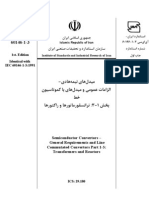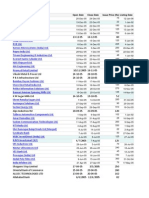Joinder of Parties StepbyStep
Joinder of Parties StepbyStep
Uploaded by
LazinessPerSeCopyright:
Available Formats
Joinder of Parties StepbyStep
Joinder of Parties StepbyStep
Uploaded by
LazinessPerSeOriginal Description:
Copyright
Available Formats
Share this document
Did you find this document useful?
Is this content inappropriate?
Copyright:
Available Formats
Joinder of Parties StepbyStep
Joinder of Parties StepbyStep
Uploaded by
LazinessPerSeCopyright:
Available Formats
JOINDER OF PARTIES STEP-BY-STEP
1) R.20 Permissive Joinder of Parties
a) R. 20(a) Usage: Governs initial joinder of plaintiffs or defendants in the Ps original claim. b) R.20(a) Test 1: Does the person assert a claim arising out of the same transaction or occurrence (or series of transactions or occurrences)? c) R.20(a) Test 2: Does the persons claim share common questions of law/fact with the original claim? d) Notes: Can add both Ps and Ds in the same action.
2) R.19 Required Joinder of Parties
a) R.19 Usage: Applies when an absent person is required / should be added as a P or D. b) R.19 Situation 1: In a persons absence, court cannot accord complete relief among existing parties. i) Example: TF leases 3 floors from GLC, then sublets to A. A wants more electrical power. TF refuses because GLC refuses, and GLC is the owner. A sues TF. Judgment against TF wouldnt change anything because GLC is in control, not TF. c) R.19 Situation 2: Person who claims an interest related to the subject matter of the case should be made a party if proceeding without them might impair their ability to protect that interest. i) Example: G sues Acme to get stock reissued in his name as well as Hs. Hs interest is affected. d) R.19 Situation 3: Resolving the case without a nonparty person would expose one of the original parties to a risk of multiple or inconsistent obligations. i) Example: Bank holds money in escrow for C. C sues Bank for money, claiming repairs were made. B sues Bank for money, claiming repairs were inadequate. Bank whipsawed. e) Notes: Satisfying any Situation requires joinder so long as the new party doesnt break SMJ. R.19(b) covers what a court does when a nonparty person should be joined but cant.
3) R.14 Impleading a 3rd Party
a) R.14(a) Usage: Applied when a Defending Party / Plaintiff want to bring in a new person. b) R.14(a) Test: Defending party may (as 3rd party plaintiff) assert claim on a nonparty who is or may be liable for all or part of the claim against it.
c) Notes: R.14(a)(2) covers the impled 3rd partys responses. Impled 3rd party doesnt count for SMJ, but does count for PJ. R.14(b) allows Plaintiff to use R.14(a) when claim is asserted against Plaintiff.
4) R.22 Interpleader
a) R.22 Usage: Rule interpleader provides a remedy for any person who is, or may be exposed to double or multiple liabilities. The stakeholder may invoke Rule 22 as a plaintiff, or by counter-claiming in an action already started against him by one, or more claimants. There is no deposit required to be made with the court for a Rule 22 interpleader action. The stakeholder may claim that they are not liable in whole, or part, to any or all the claimants. b) Diversity: Complete diversity between stakeholder and all claimants required. c) AIC: Stake must exceed $75,000. d) Notes: R.22(b) explains how it interacts with R.20 and 1335 Interpleader.
5) 1335 Interpleader
a) 1335 Usage: Allows an individual with a stake which is, or may be, claimed by two or more adverse claimants, to interplead those claimants and bring them into a singular action. A Statutory Interpleader action is commenced by the stakeholder who must initially deposit with the court, the AIC, or post a specific bond with the court. The stakeholder may, however, at trial claim they don't owe money to the claimants at all. b) Diversity: Diversity is satisfied as long as there are two claimants of different states. For example, if you have three claimants, two of which are residents of Florida, and one from California, diversity would be satisfied. The diversity of the stakeholder, however, is irrelevant to the rule. c) AIC: Stake in claim = AIC. Must be > or = $500. d) Service: Under 2361, a person anywhere within the US may be served by the stakeholder.
6) R.24 Intervention by Right
a) R.24(a) Usage: Applied when an absent person takes initiative to join in a case. b) R.24(a) Test 1: Does the absent person claim an interest relating to the property or transaction that is the subject matter of the action? c) R.24(a) Test 2: Will that interest, as a practical matter, be impaired if the person is not allowed to participate in the case? d) R.24(a) Test 3: The absent persons interest is not adequately represented by existing parties. e) Notes: Must meet all 3. Generally if person fits R.19(a)(1)(B)(i), they meet R.24(a)(2) as well. R.24(a)(1) covers statutorily-granted intervention.
7) R.24 Permissive Intervention
a) R.24(b) usage: Applied when an absent person takes initiative to join a case, but cant use R.24(a). b) R.24(b) Test: Absent person has a claim or defense that shares a common question of law/fact with the main action. c) Notes: R.24(b)(3) limits scope if intervention creates undue delay/prejudice.
You might also like
- Evidence Outline - Fisher CasebookDocument83 pagesEvidence Outline - Fisher Casebookice8080100% (6)
- Moshe Admon Legal MemoDocument13 pagesMoshe Admon Legal Memojeff_admon100% (1)
- Joinder ChartDocument3 pagesJoinder ChartDavid Patton100% (3)
- Civ Pro Pleading FlowchartDocument1 pageCiv Pro Pleading FlowchartWaylon Fields82% (11)
- Civ Pro Flow ChartsDocument32 pagesCiv Pro Flow Chartslonghorn77100% (13)
- Issue Preclusion: (No Fraud, Lack of SMJ, Venue, Joinder, Oppty To Be Heard Issues) No IpDocument8 pagesIssue Preclusion: (No Fraud, Lack of SMJ, Venue, Joinder, Oppty To Be Heard Issues) No Ipsgussack100% (4)
- Civ Pro Attack SheetDocument1 pageCiv Pro Attack Sheetsumsanslimites82% (11)
- Civ Pro Skeleton AnswersDocument5 pagesCiv Pro Skeleton AnswersWyattjames4100% (14)
- Evidence Flow Chart 2008-09Document10 pagesEvidence Flow Chart 2008-09Viana83100% (24)
- Essay Format Strict Product Liability (MFG)Document2 pagesEssay Format Strict Product Liability (MFG)Harley Meyer100% (1)
- FRCP 26 ChartDocument1 pageFRCP 26 ChartRonnie Barcena Jr.50% (6)
- Civil Procedure - Erie EssayDocument2 pagesCivil Procedure - Erie Essayjustgottabezen100% (1)
- Joinder of Claims ChartDocument1 pageJoinder of Claims ChartRonnie Barcena Jr.No ratings yet
- Civil Procedure FRCP TableDocument20 pagesCivil Procedure FRCP TableIsaiah Paramore100% (2)
- Civpro FlowchartDocument4 pagesCivpro FlowchartDawn J. Owens100% (7)
- Worksheet MerchandisingDocument6 pagesWorksheet MerchandisingLyca Mae CubangbangNo ratings yet
- Erie Doctrine FlowchartDocument1 pageErie Doctrine FlowchartElizabeth Andonova100% (2)
- Erie Doctrine Flow ChartDocument1 pageErie Doctrine Flow Chartdmt320100% (2)
- Constitutional Law Essay Rules For Bar ExamDocument14 pagesConstitutional Law Essay Rules For Bar ExamT Sheth100% (6)
- Rules Draft 1Document4 pagesRules Draft 1Rishabh Agny100% (1)
- Case Study of Build A BearDocument4 pagesCase Study of Build A BeartnssbhaskarNo ratings yet
- MIP Gartner Ashish SourabhDocument57 pagesMIP Gartner Ashish SourabhAshish MalhotraNo ratings yet
- CivPro Joinder ReviewDocument4 pagesCivPro Joinder ReviewCarly Moskowitz McClain50% (2)
- Civ Pro ChartDocument13 pagesCiv Pro ChartAshley Danielle100% (4)
- Preclusion Step by StepDocument2 pagesPreclusion Step by StepLazinessPerSe100% (2)
- CivPro - FRCP TableDocument10 pagesCivPro - FRCP TablecathyNo ratings yet
- CivPro Joinder ChartDocument2 pagesCivPro Joinder ChartBrianna Hills50% (2)
- Exam Answer Outline-TortsDocument3 pagesExam Answer Outline-TortsAhmad A. Hussein100% (1)
- 11remedies ChecklistDocument1 page11remedies ChecklistJeremy WangNo ratings yet
- Torts One SheetDocument2 pagesTorts One SheetChris Hamer100% (3)
- Discovery Civ ProDocument53 pagesDiscovery Civ ProAlexis R GaryNo ratings yet
- CrimLaw AttackDocument31 pagesCrimLaw AttackLazinessPerSe100% (10)
- 3 - Oracle EBS Mobile ApplicationsDocument27 pages3 - Oracle EBS Mobile ApplicationsMahdi AjoudanianNo ratings yet
- Duke SIP Project ReportDocument61 pagesDuke SIP Project Reportarijit maity100% (1)
- Joinder of Claims StepbyStepDocument1 pageJoinder of Claims StepbyStepLazinessPerSe100% (2)
- Freer Lecture OutlineDocument10 pagesFreer Lecture Outlinesublime12089No ratings yet
- Claim & Issue PreclusionDocument1 pageClaim & Issue Preclusionkevand123No ratings yet
- Civ Pro Case ChartDocument14 pagesCiv Pro Case ChartMadeline Taylor DiazNo ratings yet
- Claim Preclusion Attack OutlineDocument2 pagesClaim Preclusion Attack OutlineRonnie Barcena Jr.100% (3)
- Civ Pro ChecklistsDocument13 pagesCiv Pro ChecklistsNick Van LeuvenNo ratings yet
- Freer Review Complete!Document27 pagesFreer Review Complete!Kevin Hagler100% (3)
- Pleadings Step by StepDocument3 pagesPleadings Step by StepLazinessPerSe100% (3)
- Joinder-Big Picture: R J I R Diver TyDocument1 pageJoinder-Big Picture: R J I R Diver Tysafkdjafgh leeeNo ratings yet
- Civ Pro AttackDocument24 pagesCiv Pro AttackEvan Miller100% (1)
- Civ Pro Attack Outline (Scribd)Document3 pagesCiv Pro Attack Outline (Scribd)Madeline Helms100% (1)
- Evidence Mini ReviewDocument10 pagesEvidence Mini ReviewAna Lucia MarquezNo ratings yet
- Criminal Procedure Final Outline - RonnerDocument106 pagesCriminal Procedure Final Outline - Ronnerjames1100% (1)
- Civil Procedure Attack Outline 2010Document7 pagesCivil Procedure Attack Outline 2010Thomas Jefferson100% (2)
- Erie Doctrine OutlineDocument4 pagesErie Doctrine OutlineDavid Jules Bakal100% (1)
- Remedies Outline CutDocument2 pagesRemedies Outline CutErica Chavez100% (2)
- Civ Pro Flow ChecklistDocument8 pagesCiv Pro Flow ChecklistSarah BrathwaiteNo ratings yet
- Supplemental Jurisdiction 2Document1 pageSupplemental Jurisdiction 2Vince DePalmaNo ratings yet
- CivPro - InterpleadersDocument2 pagesCivPro - InterpleadersLaura CNo ratings yet
- Civil Procedure RoadmapsDocument15 pagesCivil Procedure RoadmapsCarolina JordanNo ratings yet
- Law School Outline Keyed To Civil Procedure Freer 7th Ed - Wiki Law SchoolDocument39 pagesLaw School Outline Keyed To Civil Procedure Freer 7th Ed - Wiki Law SchoolACDCNo ratings yet
- Supplemental Jurisdiction FlowchartDocument1 pageSupplemental Jurisdiction FlowchartYenisNo ratings yet
- Civil Procedure - Freer Fall 00 01Document27 pagesCivil Procedure - Freer Fall 00 01lssucks1234No ratings yet
- Yeazell Civ Pro OutlineDocument37 pagesYeazell Civ Pro OutlineLaura SkaarNo ratings yet
- FL Con Law OutlineDocument28 pagesFL Con Law OutlineassiramufNo ratings yet
- Civil Procedure Bare Bones OutlineDocument9 pagesCivil Procedure Bare Bones OutlineLindaNo ratings yet
- Flow Charts Civ ProDocument24 pagesFlow Charts Civ Procdgallo9100% (10)
- Civil Procedure II Pre-Writes: InterventionDocument24 pagesCivil Procedure II Pre-Writes: InterventionMorgyn Shae Cooper50% (2)
- Passing the Uniform Bar Exam: Outlines and Cases to Help You Pass the Bar in New York and Twenty-Three Other States: Professional Examination Success Guides, #1From EverandPassing the Uniform Bar Exam: Outlines and Cases to Help You Pass the Bar in New York and Twenty-Three Other States: Professional Examination Success Guides, #1Rating: 2.5 out of 5 stars2.5/5 (3)
- Business Organizations: Outlines and Case Summaries: Law School Survival Guides, #10From EverandBusiness Organizations: Outlines and Case Summaries: Law School Survival Guides, #10No ratings yet
- Property OutlineDocument14 pagesProperty OutlineLazinessPerSe100% (2)
- Habeas Corpus AnalysisDocument6 pagesHabeas Corpus AnalysisLazinessPerSeNo ratings yet
- Property Review OutlineDocument22 pagesProperty Review OutlineLazinessPerSe100% (1)
- Parol Evidence Rule Step by StepDocument2 pagesParol Evidence Rule Step by StepLazinessPerSe100% (4)
- UE - MO Step by StepDocument2 pagesUE - MO Step by StepLazinessPerSeNo ratings yet
- Supervening Issues Step by StepDocument2 pagesSupervening Issues Step by StepLazinessPerSeNo ratings yet
- Interpretation - Construction Step by StepDocument2 pagesInterpretation - Construction Step by StepLazinessPerSe100% (1)
- Conditions Step by StepDocument1 pageConditions Step by StepLazinessPerSe100% (1)
- Improper Bargaining Step by StepDocument3 pagesImproper Bargaining Step by StepLazinessPerSe100% (1)
- Joinder of Claims StepbyStepDocument1 pageJoinder of Claims StepbyStepLazinessPerSe100% (2)
- Pleadings Step by StepDocument3 pagesPleadings Step by StepLazinessPerSe100% (3)
- 12 (B) (6) Vs Summary Judgment StepbyStepDocument1 page12 (B) (6) Vs Summary Judgment StepbyStepLazinessPerSe50% (2)
- Vision and Value System of Akio Morita That Drove Him To Build A Highly Respected MNC From ScratchDocument3 pagesVision and Value System of Akio Morita That Drove Him To Build A Highly Respected MNC From ScratchSarah PandaNo ratings yet
- 4 Co v. CADocument8 pages4 Co v. CA유니스No ratings yet
- Quiz I - Answer SheetDocument24 pagesQuiz I - Answer Sheetarno6antonio6spinaNo ratings yet
- International Institute of Certified Accountants International Institute of Certified Accountants International Institute of Certified Accountants International Institute of Certified AccountantsDocument10 pagesInternational Institute of Certified Accountants International Institute of Certified Accountants International Institute of Certified Accountants International Institute of Certified AccountantsMansoor AliNo ratings yet
- Write A Report To Analyse The Key Factors Which Drive GlobalizationDocument7 pagesWrite A Report To Analyse The Key Factors Which Drive GlobalizationChúc Linh Đặng ThịNo ratings yet
- VP Director Sales Marketing Ecommerce in Orlando FL Resume John Michael ShreveDocument1 pageVP Director Sales Marketing Ecommerce in Orlando FL Resume John Michael ShreveJohnMichaelShreveNo ratings yet
- Active Realty & Development Corporation, Petitioner, Daroya-Quinones, RespondentsDocument6 pagesActive Realty & Development Corporation, Petitioner, Daroya-Quinones, RespondentsGH IAYAMAENo ratings yet
- A Study On Promotional Mix of Insurance Products and Its Importance On The Growth of The CompanyDocument63 pagesA Study On Promotional Mix of Insurance Products and Its Importance On The Growth of The CompanyNagireddy Kalluri100% (1)
- Marketing 4ADocument24 pagesMarketing 4AЭуженио МигелNo ratings yet
- Top PGDM College in Pune IIMS Elite ProgramDocument7 pagesTop PGDM College in Pune IIMS Elite ProgramRahul BatraNo ratings yet
- John Carroll Magazine Spring 2008Document68 pagesJohn Carroll Magazine Spring 2008johncarrolluniversityNo ratings yet
- Catalog Tongs BV and WRTDocument136 pagesCatalog Tongs BV and WRTchaallahadelNo ratings yet
- Packing List 1058Document6 pagesPacking List 1058hernan saavedraNo ratings yet
- Module 3 - Accounting For Business TransactionsDocument10 pagesModule 3 - Accounting For Business TransactionsMJ San PedroNo ratings yet
- Adoption IEC 60146 1 3Document7 pagesAdoption IEC 60146 1 3dfcghvbhjbNo ratings yet
- SAP OverviewDocument34 pagesSAP Overviewนพ บีเคเค100% (2)
- LS Advanced ECommerce Marketing EbookDocument141 pagesLS Advanced ECommerce Marketing EbookAndreeaNo ratings yet
- All Cargo All Cargo LogisticsDocument24 pagesAll Cargo All Cargo LogisticsMishal Jain100% (1)
- Ipos in 2005Document10 pagesIpos in 2005kartheek_bharadwajaNo ratings yet
- Financial Reporting Cia - I: Reasons For Regulatory FrameworkDocument5 pagesFinancial Reporting Cia - I: Reasons For Regulatory FrameworkPrateetNo ratings yet
- Executive Letter Judge W. BreitkruzDocument7 pagesExecutive Letter Judge W. Breitkruz:Nanya-Ahk:Heru-El(R)(C)TM100% (2)
- International Financial Management: Assignment # 1Document7 pagesInternational Financial Management: Assignment # 1Sadia JavedNo ratings yet
- Bank ReconciliationDocument2 pagesBank ReconciliationRyoma EchizenNo ratings yet
- 0216Document96 pages0216ZoeNo ratings yet
- JKBJDocument12 pagesJKBJChampyNo ratings yet




































































































